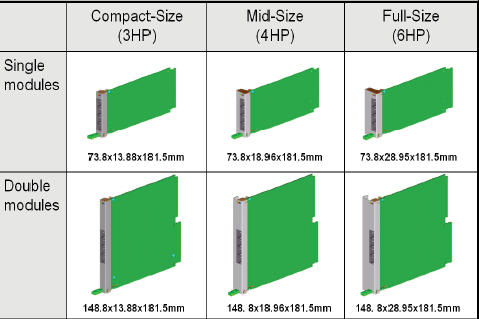AMC – Advanced Mezzanine Card
The PICMG Advanced Mezzanine Card (AdvancedMC, AMC, AMC module) specification describes computer interface cards. The original purpose was to define a successor format for PCI Mezzanine Cards (PMCs) for use as a hot-swappable mezzanine module for AdvancedTCA systems. Later, the PICMG MicroTCA specification defined enclosure systems for the operation of AMC modules. They can be plugged in from the outside and therefore allow the construction of systems that are easy to maintain.
AMCs can have any function, e.g. I/O or CPU modules. As each AMC slot can accommodate a CPU module, multi-processor systems can also be easily implemented.
Module formats and front panels
The AMC board has a format of 181.5 x 73.8 mm²; there are also double-size boards with 181.5 x 148.8 mm². The front panel formats compact (3HP), mid-size (4HP) and full-size (6HP) allow a total of six module sizes. The most common are mid-size or full-size AMC modules.
Card interface
The AMC module has a 170-pin card connector with 20 serial high-speed ports and 5 clock lines. The ports are bidirectional differential pairs, the clock lines are also differential signals. Two leading presence pins are used to control the power control function (in the MicroTCA system or on the carrier board). The management interface (I²C bus) uses two pins, three pins are used for geographical addressing. There is an enable signal and five JTAG test lines. The module power supply is provided by a 12V voltage (Payload Power, PP) and an additional 3.3V voltage (Management Power, MP). There are 8 pins available for the Payload Power, 1 pin for the Management Power and a number of 56 ground lines. The high number of payload power pins allows high supply currents and therefore high module power losses of maximum 80 watts.
Port Usage
Various sub-specifications define the use of the AMC ports. The possible protocols are Gigabit and 10 Gigabit Ethernet, PCIe, Serial RapidIO, SATA, SAS and Fibre Channel.
Management
An AMC module communicates with the carrier via IPMI commands. The basics for the management functions between carrier and AMC module are defined in the AdvancedMC and AdvancedTCA specifications. For example, an AMC module provides information about power requirements, supported interfaces and operating temperature. The management functions enable module reset, power on/off and also allow more complex operations such as a firmware update.
Advantages of AMC modules
The use of AMC modules in industrial computers or their construction based on AMC modules offers many advantages: Up to 6 (six) PCIe root complexes, high data throughput, protocol diversity, high possible power dissipation, system management and hot-swap make an application future-proof and durable. The serviceability of AMCs, their long product life and the stability of this industry standard create investment security and keep total costs low.




